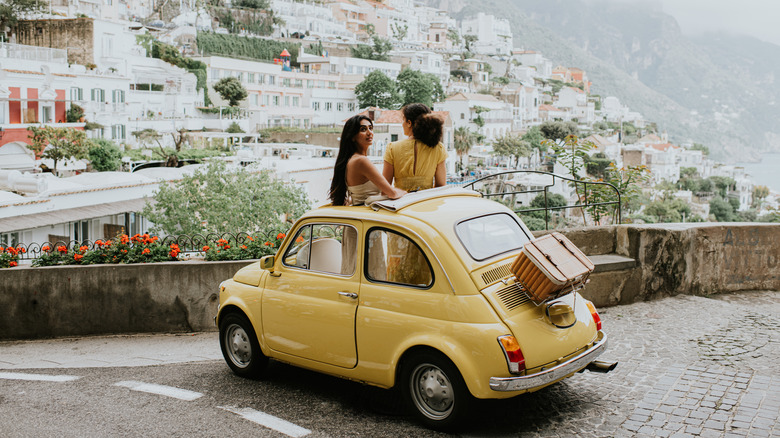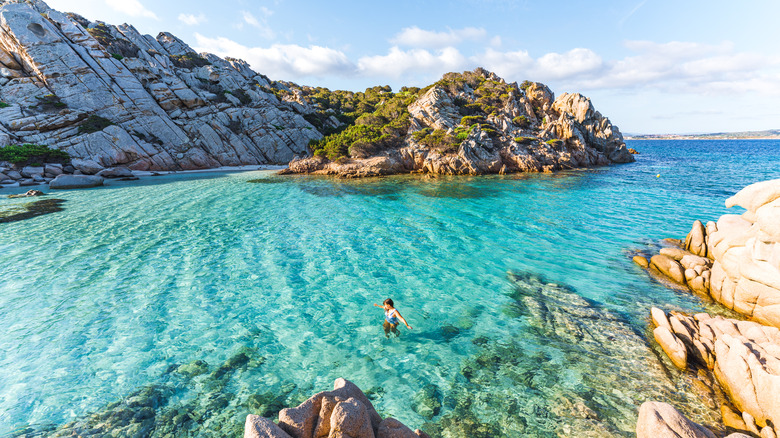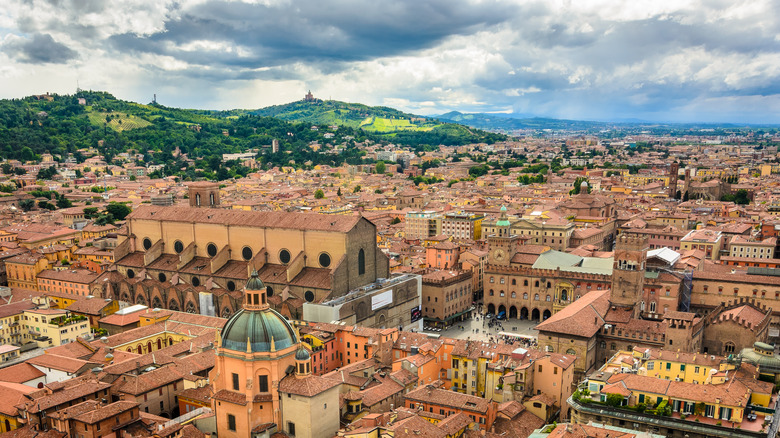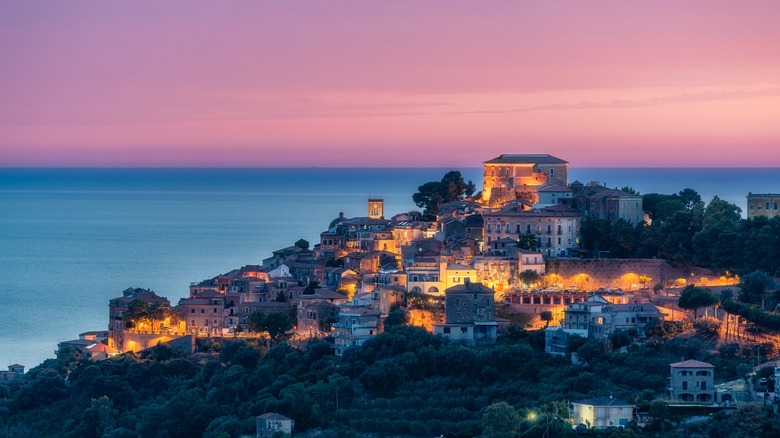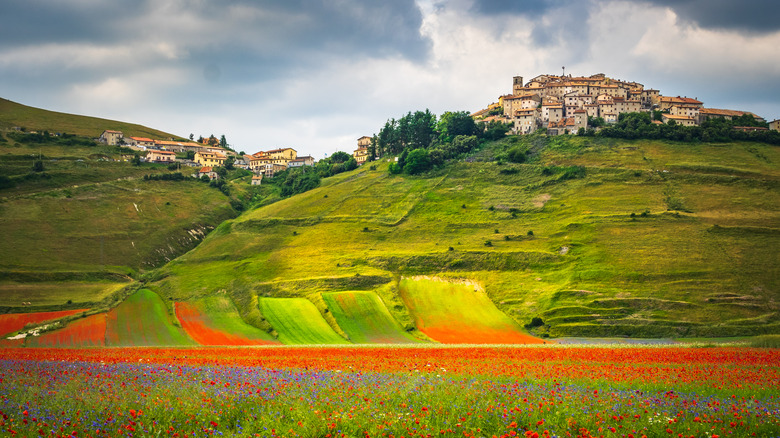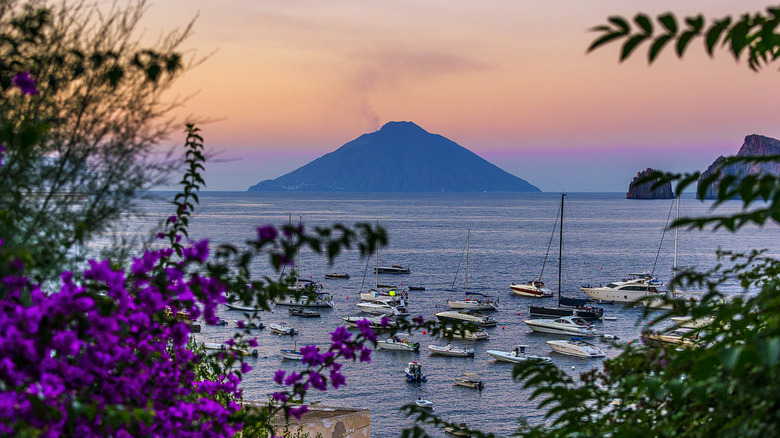The 5 Best Destinations Locals Want You To Visit In Italy
Italy has a staggering number of towns. How many? Just under 8,000. From medieval hill towns and massive cities to ancient metropolises and serene beach locales, deciding where to go on your Italian vacation is no easy decision. And so, many settle for the holy trinity of Rome, Venice, and Florence, with the occasional day trip here and there to the tourist-infested Amalfi Coast, Lake Como, Pisa, and Verona, among other spots. What if you went where locals go?
Indeed, there is much more to see and experience in Italy — a country of rich history, stunning landscapes, and world-class cuisine — beyond these bucket list places. In fact, the very "dolce vita" of Italy lies off the beaten path in regions like Sardinia, Emilia-Romania, Campania, Umbria, and Sicily. These underrated locales will push you beyond the tourist crowds into real Italian life in the city, an island, or a tiny little town. Here are the five best destinations you should visit in Italy that are beloved by locals for their authenticity and charm.
Sardinia
Italy is renowned for its iconic geographical shape that looks like a boot about to kick a ball. That ball is the island region of Sardinia — seldom visited by tourists outside of Italy or Europe, probably because it's disconnected from the mainland. Sardinia is the second-largest island in the Mediterranean, and it's a paradise of pristine beaches, crystal waters, and rugged landscapes. It's also known for its ancient history and unique culture (they even have their own language!), this island is a mix of experiences.
Begin your adventure to Cagliari, the island's capital. Venture into the historic Castello district to see the Bastione di Saint Remy fort and the Cagliari Cathedral. Time your visit in May to attend the Feast of Sant'Efisio festival, or in the winter, for the Carnival di Mamoiada. For natural beauty, hike the many scenic trails at Gennargentu National Park. For something a little peculiar, go to the island of Asinara, a protected park that is deserted for most of the year, except for its indigenous white donkeys who call it home.
Adventure to the 12-mile-long Costa Smeralda, famous for its emerald waters and luxury resorts, or check out La Pelosa near Stintino, one of the best beaches in Sardinia. For a slice of history, visit the Su Nuraxi Nuraghe, an ancient stone settlement dating back to the Bronze Age and a UNESCO World Heritage Site. Don't miss the mysterious Giants' Graves scattered throughout the island. Finally, savor Sardinian cuisine and the local pecorino cheese.
Bologna in Emilia-Romagna
The capital city of the Emilia-Romagna region, Bologna is heaven for food lovers — known as "La Grassa" (The Fat One), Bologna is responsible for a variety of gastronomic delights that have influenced Italian cuisine worldwide. Ragù alla Bolognese, Parmigiano Reggiano, Mortadella, and the unmistakable, world-famous lasagna are just some of the "humble" exports of this city. They even have an annual Mortadella festival that happens every October. With all that cheesy, meaty, and oily goodness, Bologna is the high-cholesterol, beating culinary heart of Italy.
"The Red," or "La Rossa," is another nickname for Bologna, and you'll notice that by the red brick architecture, but if you climb to the top of the Asinelli Tower and see the terracotta tiled roofs, you'll definitely understand the meaning behind the name. Check out Piazza Maggiore, a public square surrounded by historic buildings, like the Basilica di San Petronio and the Palazzo d'Accursio, and many lively cafes. Montagnola Market (open every Friday and Saturday) is a must-visit if you love vintage and secondhand shopping. Who knows what gems you'll find!
Another nickname for Bologna is "The Learned" ("La Dotta"). Why? The oldest university in the Western world, Bologna University, was founded here in 1088. Many students live in the city which renders the lusty and vibrant Bologna another edge: non-stop nightlife. Summer festivals (many of which are food or party-focused), lively aperitivo hours, underground discos, and sunset cocktails at Piazza Verdi are the vibe here. Better yet, you'll be among locals.
Cilento in Campania
The coastal Cilento region, located in the southern part of Campania, is truly a hidden gem. Consider skipping the Amalfi Coast for this instead, because Cilento is less crowded and provides a much more authentic and tranquil experience. Plus, it's only around two hours away from the Amalfi Coast. Locals cherish Cilento for its natural beauty, breathtaking landscapes, ancient ruins, pristine beaches, and medieval villages. This is one of Italy's best-kept secrets.
Start with Paestum, with its well-preserved ancient Greek ruins and fascinating Archaeological Park of Paestum. It also has a beautiful, 9-mile-long sandy beach. Head to Castellabate, a medieval village with coastal views, perfect for wandering its narrow streets and enjoying local cuisine. For nature lovers, the Cilento and Vallo di Diano and Alburni National Park, a UNESCO World Heritage Site, offers scenic, well-marked hiking trails through diverse landscapes. It's also one of the largest national parks in Italy, boasting 180,000 hectares of protected land.
After, relax on the pristine beaches of Palinuro, known for sea caves like the ethereal Blue Grotto (best to visit in the mid to late afternoon for the magical light show). Don't miss the village of Acciaroli, where Ernest Hemingway once stayed, offering a glimpse into authentic Italian coastal life. Savor local produce like DOC Cilento and Castel San Lorenzo wines, white figs, Caciorioccota cheese, and Menaica anchovies, for a true taste of Cilento. Fun fact: Cilento is the birthplace of the legendary Mediterranean Diet. Need we say more?
Norcia and Spello in Umbria
Many flock to Umbria to visit Assisi, the birthplace of St.Francis and a famous pilgrimage site. However, Norcia and Spello, two Umbrian towns just one hour's drive apart, offer a glimpse into small-town Italian life. Norcia is famous for its black truffles and cured meats, while Spello is renowned for its flower festival and well-preserved Roman architecture. But there is much more than seeing the sights and trying the foods here — it's about the lifestyle. The sense of community and tradition is strong, which makes both beloved by locals.
In Norcia, start by exploring the historic Piazza San Benedetto and Basilica of Saint Benedict, dedicated to Norcia's most famous native. Stroll through the charming streets, admiring medieval architecture and quirky local shops. Check out the mountain hamlet of Castellucia di Norcia for its beautiful views of the Sibillini Mountains and the beautiful spring flowers at the Plateaus of Castellucio. For food, try local specialties like black truffles, Norcia ham, and Castellucio lentils.
Also known as "the flower town," the charming and budget-friendly Spello is truly underrated. But, what's with the flowers? Because of the Infiorate di Spello festival that happens every June, where the streets are decorated with elaborate floral carpets and murals for Corpus Domini. 15 million flowers from 65 different species turn the city into a fairy tale! Even outside the flower festival, there is much to do in Spello: Church of Santa Maria Maggiore, try Umbrian wine, and walk along ancient aqueducts.
Aeolian Islands in Sicily
Italy has no shortage of volcanoes. In fact, it is the most actively volcanic place in mainland Europe. Campi Flegrei, a volcanic caldera located in Naples has seen some seismic unrest, and everyone knows about the most active stratovolcano in the world, the notorious and iconic Etna volcano in Sicily. The infamous Mount Vesuvius volcano and the city of Pompeii see fair, fair share of tourists.
But few venture as far out as the Aeolian Islands, a volcanic archipelago of seven islands — Lipari, Vulcano, Salina, Panarea, Stromboli, Filicudi, and Alicudi — off the northern coast of Sicily. A paradise of volcanic landscapes, charming villages, and impeccable Tyrrhenian Sea beaches, each Aeolian island has its own unique character and attractions worthy of thrilling exploration and leisurely island hopping. Locals appreciate the islands for their natural beauty and tranquility — the slower pace of life can be felt immediately, and close-knit communities add to the laidback vibe.
Stromboli, an island with an active volcano called Stromboli, is the place for adrenaline-seeking travelers. Take a guided hike at night to the top and witness its spectacular, magmatic eruptions up close (safely). Salina, a very green and quaint island, feels local — visit some of its Malvasia vineyards, rent a motorbike to enjoy its traffic-free roads, and hike to Monte Fossa Felci. Lipari, the biggest of the Aeolian Islands, has plenty of restaurants, boutiques, and a must-visit archeological museum. Vulcano, the sulfurous island, is known for therapeutic mud baths and black sand beaches.
